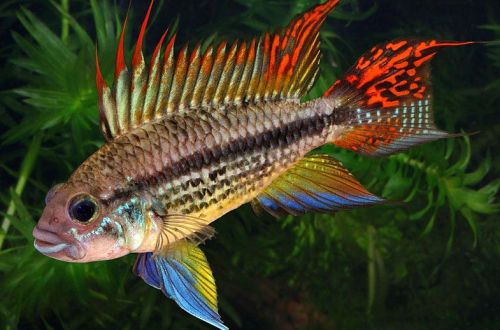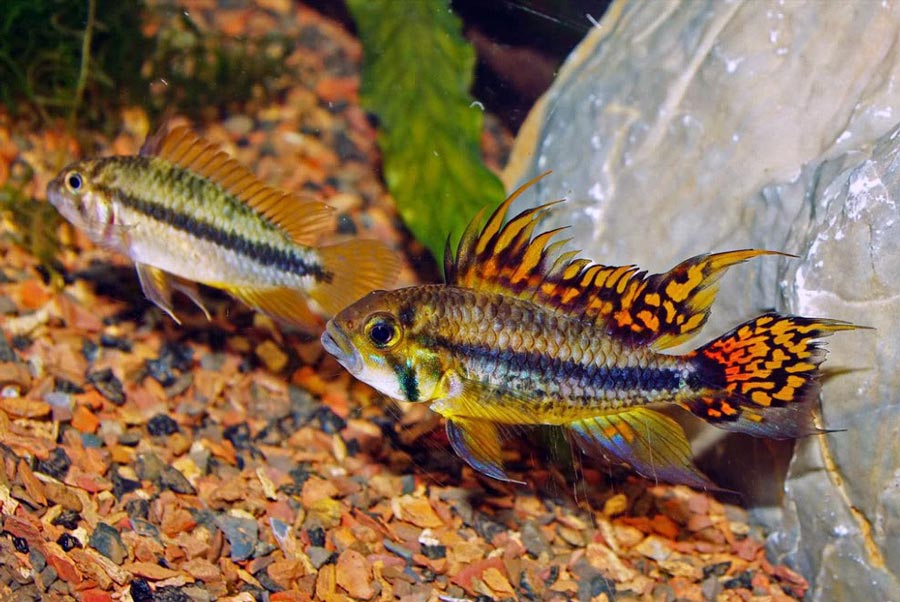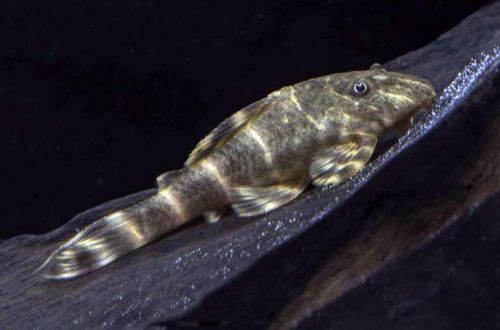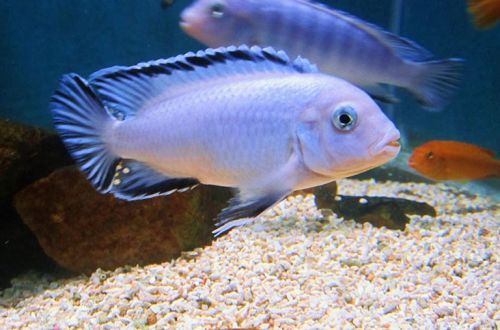
Cockatoo Apistogram
Apistogramma Kakadu or Cichlid Kakadu, scientific name Apistogramma cacatuoides, belongs to the Cichlidae family. One of the brightest representatives of South American cichlids, able to decorate any freshwater aquarium. In addition to beautiful coloring, it also has other advantages – simplicity in maintenance, unpretentiousness, friendly disposition. May be recommended for beginner aquarists.

Contents
Habitat
It originates from South America from the basins of the Ucayali and Amazonas rivers in Peru and further in the Solimões River and its tributaries in western Brazil. Prefers regions with a slow current, flooded areas of tropical forest, swamps. In their natural habitat, reservoirs are littered with fallen leaves, fruits, tree branches, from which the water acquires a rich brownish tint due to the abundance of dissolved tannins.
Brief information:
- The volume of the aquarium – from 60 liters.
- Temperature – 22-29°C
- Value pH — 5.0–7.0
- Water hardness – very soft to medium hard (1-15 dGH)
- Substrate type – sandy
- Lighting – subdued
- Brackish water – no
- Water movement is weak
- The size of the fish is 5–7.5 cm.
- Nutrition – meat feed
- Temperament – peaceful, except during spawning periods
- Keeping in a group with one male and several females
Description

Adults reach a length of about 5–7 cm. Males are somewhat larger and have a large dorsal fin resembling a comb, painted in bright fiery colors, and the tail has a similar color. Such an original appearance is reflected in the colloquial name – “Kakadu”. Females are noticeably smaller and much more modestly colored than males.
Breeding forms have gained wide popularity, depending on the prevailing color, they have prefixes to their name, such as “Sunset”, “Double Red”, “Triple Red”, “Gold”, “White Gold”, “Orange Flash” and “Albino”. “.
Food
They belong to carnivorous species, in nature they feed on benthic invertebrates, small aquatic insects and their larvae, crustaceans. In a home aquarium, it is advisable to provide live or frozen food in the diet, for example, bloodworms, daphnia, brine shrimp. However, often the fish are accustomed to dry sinking food in the form of flakes or granules with a large amount of protein in the composition. It is an alternative to meat products.
Arrangement of an aquarium
The vast majority of Cockatoo Cichlids sold in the European and Asian markets come from commercial fish farms, where they have been living in the artificial environment of aquariums for many generations, therefore they have successfully adapted to various water conditions. Decoration is also not essential and can be selected based on the preferences of the aquarist.
For those who want to make the aquarium look like a natural habitat, you can use the following recommendations. Use a sandy substrate in the design, a few snags overgrown with moss or ferns, rooting and floating plants. The lighting is subdued. The addition of beech, oak or Indian almond leaves will give the water a characteristic tea color. A similar effect can be achieved by using special essences.
The leaves, before being placed in the aquarium, are first dried and then soaked until they begin to sink. As for Indian almonds (its leaves, bark) are supplied already prepared for use.
Behavior and Compatibility
Quite a peaceful calm fish, can get along with most species of similar size and temperament. In order to avoid possible intraspecific conflicts, it is worth limiting yourself to one male in a company with several females. Also, do not keep together with other Apistograms, otherwise there is a high risk of hybrid offspring, it is better to leave this to experienced breeders.
Breeding / breeding
Under favorable conditions (suitable hydrochemical composition and water temperature), the probability of the appearance of fry is very high. The chances increase significantly when kept in soft, slightly acidic water. With the beginning of the mating season, the male can show signs of attention to several females at once, each of which will give offspring. In this case, it should be provided that the number of shelters coincides with the number of females, and they are located at a distance from each other.
During spawning, the female lays her eggs in safe shelters and remains near the clutch to protect her. When the fry appear, she will continue to take care of them, protecting them from strangers. The male is also involved in the protection of offspring, however, often he becomes overly aggressive and has to be temporarily relocated to a separate aquarium.
Fish diseases
The main cause of most diseases is unsuitable living conditions and poor-quality food. If the first symptoms are detected, you should check the water parameters and the presence of high concentrations of hazardous substances (ammonia, nitrites, nitrates, etc.), if necessary, bring the indicators back to normal and only then proceed with treatment. Read more about symptoms and treatments in the Aquarium Fish Diseases section.





